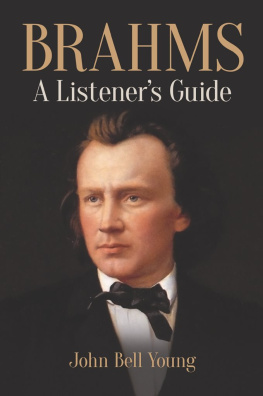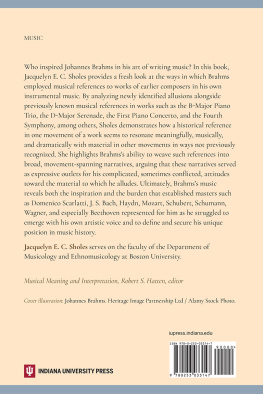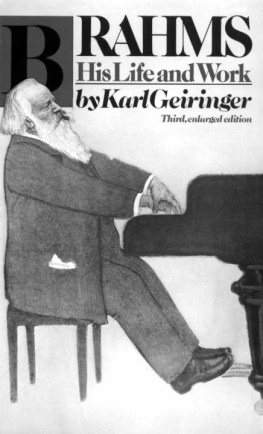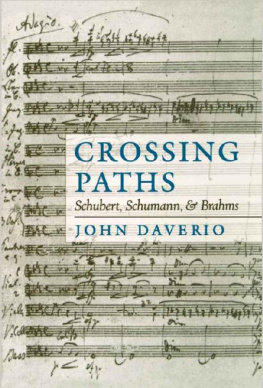Johannes Brahms GERMAN REQUIEM IN FULL SCORE From the Breitkopf & Hrtel Complete Works Edition Edited by Eusebius Mandyczewski DOVER PUBLICATIONS, INC., NEW YORK Copyright 1987 by Dover Publications, Inc. All rights reserved. This Dover edition, first published in 1987, is a republication of Volume 17 ( Ein deutsches Requiem nach Worten der heiligen Schrift fr Soli, Chor und Orchester [Orgel ad libitum], Op. 45 ) of Johannes Brahms; Smtliche Werke; Ausgabe der Gesellschaft der Musikfreunde in Wien, originally published by Breitkopf & Hrtel, Leipzig, n.d. (Editors Preface dated Spring 1926). A new table of contents, a new English list of instruments and voices, and a new English translation of the Revisionsbericht (Editors Commentary) have been added, as well as the King James Version passages of the Bible corresponding to the German vocal texts.
Library of Congress Cataloging-in-Publication Data Brahms, Johannes, 18331897.
[Deutsches Requiem]
German requiem. For soprano, bass, chorus, and orchestra.
German words.
Reprint. Originally published: Leipzig :
Breitkopf & Hrtel, 1926?
(Smtliche Werke / Johannes Brahms ; Bd. 17)
With new English translation of the editorial commentary.
English translation of words printed as text: p.
1. Requiems. I.
Mandyczewski, Eusebius. II. Title.
M2010.B8 op. 45 1987 87-751281 International Standard Book Number ISBN-13: 978-0-486-25486-9
ISBN-10: 0-486-25486-0 Manufactured in the United States by Courier Corporation
25486013
www.doverpublications.com Contents  The following sources in the collection of the Gesellschaft der Musikfreunde in Vienna served for our edition: A. the composers autograph; B. the parts used for the first Viennese performances under the direction of the composer. A. A.
The following sources in the collection of the Gesellschaft der Musikfreunde in Vienna served for our edition: A. the composers autograph; B. the parts used for the first Viennese performances under the direction of the composer. A. A.
The autograph, written on seven signatures (one for each movement) in vertical format, carries on the first page the brief title: Ein deutsches Requiem. J.B. First movement: Twelve leaves of fourteen-staff paper; after the ninth leaf an inserted leaf of eighteen-staff paper with the later changes. Title: Selig sind, die da Leid tragen. Second movement: Twelve leaves of twenty-staff paper; four leaves of twenty-staff paper of another format; four leaves of eighteen-staff paper; after the sixteenth leaf a half-leaf as an addition with the later changes. Title: Denn alles Fleisch ist wie Gras.
Third movement: Eighteen leaves of twenty-staff paper. Title: Herr, lehre doch mich. Fourth movement (originally labeled as no. 5): Twelve leaves of eighteen-staff paper. Title: Wie lieblich sind deine Wohnungen. Fifth movement: eight leaves of eighteen-staff paper.
Title: Ihr habt nun Traurigkeit. Sixth movement: Eight leaves of eighteen-staff paper; twenty-four leaves of twenty-staff paper. Title: Denn wir haben hie. Seventh movement: Fourteen leaves of twenty-staff paper. Title: Selig sind die Todten. At the end the composer notes: Baden-Baden im Sommer 1866.
The titles derived from the opening words of the individual movements were deleted by the publisher, surely only with the consent of the composer; the publisher also gave directions for engraving on the first page, and completed the text of all the movements where it was not yet self-evident. Thus the autograph was able to serve as the engraving copy, as is also apparent from the indicated division into plates. In this source the vocal parts are written in the vocal clefs, and the parts for the instruments to be used ad libitum are lackingthat is, contrabassoon and organ, whose entrances were only later indicated by the composer. B. The first edition appeared in 1868, published by Rieter-Biedermann (now C. F.
Peters) in Leipzig under the title Ein deutsches Requiem nach Worten der Heiligen Schrift fr Soli, Chor und Orchester (Orgel ad libitum) von Johannes Brahms op. 45. Partitur. Klavierauszug mit Text. Klavierauszug zu vier Hnden. Chor- und Orchesterstimmen, with the publication numbers 592596.
In the full score the organ part is missing; the organs entrances and exits are indicated in the double-bass part by Org. t. s., con Org., Org. tacet. But a completely worked-out organ part is included with the orchestral parts. In contrast, neither the full score nor the parts show any sign of the contrabassoon.
However, in his personal copy of the score the composer later indicated in blue pencil the entrances and exits of this instrument; c. Vc., c. B., tac. show where and how long it proceeds along with the cello or double bass. C. The old Viennese orchestral parts used by the composer contain a notated contrabassoon part corresponding with the indications in the above-mentioned sources.
That it is not expressly marked as an ad libitum part may have been a careless error of the copier. It is not an obligatory part, as is evident from what has been said and from its nature.  Source A reveals in detail how the composer polished and improved his work even after its completion. It is well known that he never published anything without having heard it first. So the changes in the German Requiem, too, may be traced to the effect of the first rehearsals. ix) as Example 1; and the ten measures that begin at page 17, measure 5, grew out of the seven in Example 2. ix) as Example 1; and the ten measures that begin at page 17, measure 5, grew out of the seven in Example 2.
Source A reveals in detail how the composer polished and improved his work even after its completion. It is well known that he never published anything without having heard it first. So the changes in the German Requiem, too, may be traced to the effect of the first rehearsals. ix) as Example 1; and the ten measures that begin at page 17, measure 5, grew out of the seven in Example 2. ix) as Example 1; and the ten measures that begin at page 17, measure 5, grew out of the seven in Example 2.
For the beginning of the second movement, originally only piano, mezza voce, and legato were stipulated, and for the strings legato e dolce. The inadequacy of these directions was surely proven by the rehearsals. The middle section in G-flat major, Etwas bewegter, was originally without harp. After the repeat of the first part, the B-flat major section (letter H) was to have begun Un poco animato. Three measures before letter M, the composer later inserted a measure; our Example 3 shows the original version of this passage. In the third movement, what stands out first is the notation of the clarinets; it was notated thus from the beginning.
The whole notes in the flutes beginning at letter B were originally tied to each other, as were those in the flutes and double basses eight measures after B. On page 68, measures 10 and 11, the chorus was originally meant to join the solo voice in its crescendo and decrescendo; it may have covered the soloist too much, because the composer later crossed out this performance indication and added expressly: < > gilt nur fr die Solostimme [< > holds only for the soloist]. On page 70, measure 6, the first flute was originally then was changed and explicitly marked Fl. col Oboe I. But two measures later this change is lacking, even though there seems to be no reason for it. For one thing, the b b 3 that would thereby be called for occurs often in the work, albeit as the highest flute tone; for another, on page 72, measures 2 and 6, flute and oboe moved in tandem from the outset.
On page 83, measure 3, at the beginning of the movements final section with the great pedal point on D, the various dynamic indications are the result of corrections that the composer later made, obviously after practical experience, to the forte originally required of all the instruments. The addition of ma ben marcato to the fp in the timpani is another of these; it appears in source A but is lacking in source B. The marking for the double bass was present from the beginning and affects that instrument only. Originally the cellos were to be divided, the second group doubling the double basses. In addition, the violins, violas, and first cellos were all to play legato to the end of the movement. The composer was careful to strike out the legato slurs throughout, and included the message to the engraver: Die Bgen alle weg bis zum Schluss [Remove all slurs up to the end].
Next page










 The following sources in the collection of the Gesellschaft der Musikfreunde in Vienna served for our edition: A. the composers autograph; B. the parts used for the first Viennese performances under the direction of the composer. A. A.
The following sources in the collection of the Gesellschaft der Musikfreunde in Vienna served for our edition: A. the composers autograph; B. the parts used for the first Viennese performances under the direction of the composer. A. A. Source A reveals in detail how the composer polished and improved his work even after its completion. It is well known that he never published anything without having heard it first. So the changes in the German Requiem, too, may be traced to the effect of the first rehearsals. ix) as Example 1; and the ten measures that begin at page 17, measure 5, grew out of the seven in Example 2. ix) as Example 1; and the ten measures that begin at page 17, measure 5, grew out of the seven in Example 2.
Source A reveals in detail how the composer polished and improved his work even after its completion. It is well known that he never published anything without having heard it first. So the changes in the German Requiem, too, may be traced to the effect of the first rehearsals. ix) as Example 1; and the ten measures that begin at page 17, measure 5, grew out of the seven in Example 2. ix) as Example 1; and the ten measures that begin at page 17, measure 5, grew out of the seven in Example 2.